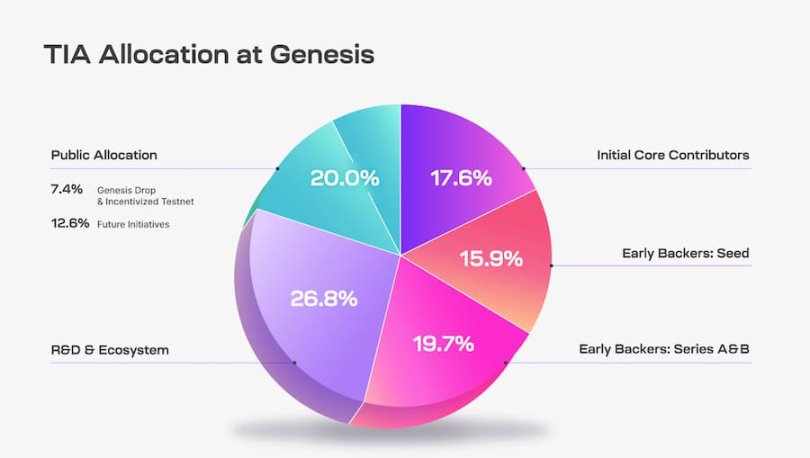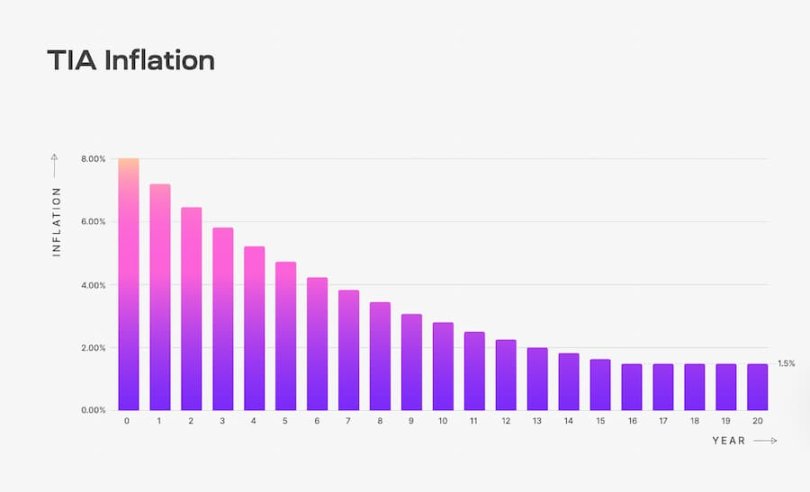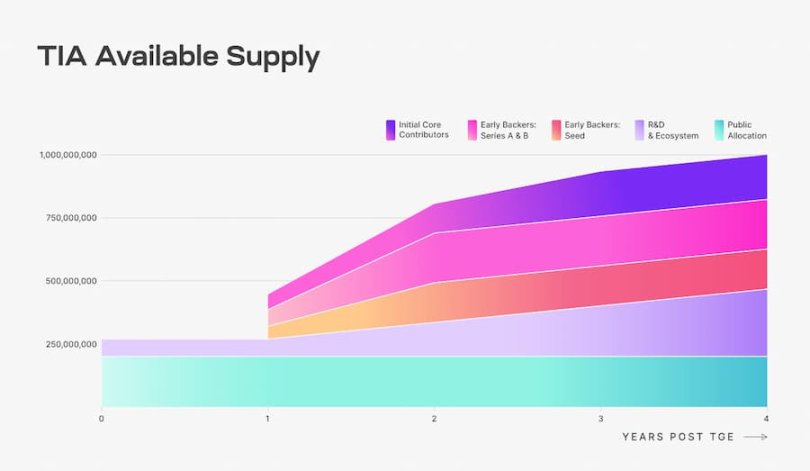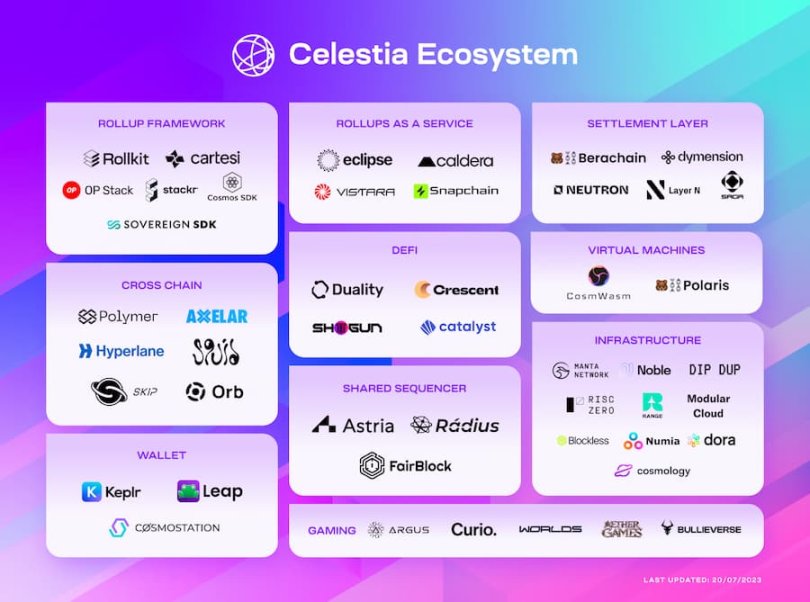Source: Celestia
Compiled by: Karen, Foresight News
Today, modular blockchain Celestia announced the release of its native token TIA and the launch of the Genesis Drop. The Genesis Drop will target 7,579 developers and 576,653 on-chain addresses on Ethereum Rollups, Cosmos Hub, and Osmosis, covering developers, ecosystem project contributors, regular users, and stakers.
Celestia is a proof-of-stake blockchain based on CometBFT and Cosmos SDK. It supports in-protocol delegation and will start with a set of 100 initial validators. Staking TIA as a validator or delegator will allow participants to earn staking rewards from the network. Validators can also charge a fee to delegators, enabling them to earn a proportion of the staking rewards.
So, what are the use cases of Celestia's native token TIA? What are the token economics and release rules? And what are the airdrop criteria?
Use Cases of TIA
Firstly, TIA is an essential component for developers to build modular data availability networks. To use Celestia for data availability (DA), Rollup developers will need to submit PayForBlobs (PFB) transactions on the network, requiring payment in TIA.
Secondly, similar to ETH on Ethereum-based Rollups, developers can choose to use TIA as a Gas token to quickly launch their chains, in addition to paying for data availability. In this mode, developers can focus on creating applications or execution layers without the immediate need to issue tokens.
Lastly, in terms of staking and network governance, as an permissionless network built using Cosmos SDK, Celestia uses proof of stake to ensure consensus. Like other Cosmos networks, any user can earn a portion of a validator's staking rewards by delegating their TIA to Celestia validators, helping to secure the network. TIA also allows the community to play a crucial role in the decentralized governance of key aspects of Celestia from day one, such as voting on network parameters and managing community pools.
From the network launch, 2% of all Celestia block rewards will go to the community pool. TIA holders can vote to spend TIA from the community pool to fund ecosystem initiatives.
TIA Token Economics
The initial total supply of TIA is 1 billion, allocated as follows:
- Public allocation: 20% (7.4% for Genesis airdrop and testnet incentives, 12.6% for future incentive allocation), fully unlocked upon release;
- 26.8% allocated to the Celestia Foundation and core developers for research, development, and ecosystem plans (25% unlocked upon release, remaining 75% unlocked from year 1 to year 4);
- 15.9% allocated to seed round early investors (33% unlocked in the first year, remaining 67% unlocked from year 1 to year 2);
- 19.7% allocated to A and B round early investors (33% unlocked in the first year, remaining 67% unlocked from year 1 to year 2);
- 17.6% allocated to initial core contributors (33% unlocked in the first year, remaining 67% unlocked from year 1 to year 3).

The inflation rate of TIA starts at 8% per year and decreases by 10% annually until it reaches a long-term issuance rate of 1.5%. The exact annual inflation rates are shown in the following chart.

Regarding token release and supply changes, the initial 1 billion TIA supply at Genesis will be subject to several different unlocking schedules. All locked or unlocked tokens can be staked, and staking rewards are unlocked upon receipt.

Celestia Genesis Airdrop
The Celestia Genesis Airdrop will be distributed to 7,579 developers and 576,653 on-chain addresses on Ethereum, Rollups, Cosmos Hub, and Osmosis. The airdrop claim period will end on October 17, 2023, at 20:00. At the end of the Genesis Airdrop, any unclaimed tokens (up to 45 million TIA) will be distributed to the developers and accounts with submitted addresses.
It's worth noting that users from the United States or other prohibited jurisdictions will not be able to claim the airdrop.
1. Research and Public Goods (Allocation of 6 million TIA)
This includes Protocol Public Goods and Infrastructure (4.6 million TIA) and Eth Research Community (1.4 million TIA).
The eligibility criteria for Protocol Public Goods and Infrastructure are:
- Contributors to protocol public goods and infrastructure;
- Contributors and dependencies of Celestia;
- Contributors to EIP and BIP.

Celestia will also allocate 1.4 million TIA to members of the Eth Research forum, with specific eligibility criteria:
- Users of the Eth Research forum who created at least 1 topic or post before July 5, 2023 (excluding Celestia Labs team members and advisors).
2. Early Modular Ecosystem (Allocation of 14 million TIA)
Celestia will allocate 8.35 million TIA to contributors to organizations in the Celestia ecosystem map, as well as public contributors to Modular Summits 1 and Modular Summits 2, and participants in the Celestia Modular Researcher Program Group 1 (excluding Celestia Labs team members and advisors).

An additional 5.65 million TIA will be allocated to Github Super Contributors who have a total of at least 4 commits in all eligible repositories, with more TIA allocated to contributors with a total of at least 23 commits in research and public goods and early modular ecosystem standards.

3. Early Adopters of Ethereum Rollups (Allocation of 20 million TIA)
Early adopters of Ethereum Rollups will receive a reward of 20 million TIA, allocated to the top 50% active users of the top 10 Ethereum Rollups ranked by TVL on L2Beat, with a snapshot taken on January 1, 2023 (Ethereum block 16308181).
Ethereum Rollup Criteria
The eligible Ethereum Rollups include OP Mainnet, Arbitrum One, Arbitrum Nova, Starknet, zkSync Lite, dYdX (StarkEx), Immutable (StarkEx), SoRare (StarkEx), Loopring, and Metis Andromeda.
To determine users' on-chain activity levels, the Genesis Drop will allocate points for on-chain behavior on Ethereum and all eligible Rollups. Specific considerations include interactions with smart contracts and applications, holding ENS domains, donating to Gitcoin, gas spent, and the most recent transaction.

This part of the airdrop excludes the Hop Witch List, Hop's transaction/relay blacklist, OP Airdrop #1 witch filter, and addresses identified by Trusta Labs as likely witches based on their on-chain clustering behavior and asset transfer methods on Ethereum and Rollups.
Four, Cosmos Hub and Osmosis Stakers and IBC Relayers (Allocation of 20 million TIA)
Celestia will allocate 18.5 million TIA to Cosmos Hub and Osmosis stakers and delegators (≥ $75), inviting them to join Celestia and participate in protecting and managing the network. The snapshot occurred before January 1, 2023, at Cosmos Hub block 13482205 and Osmosis block 7592794.
The allocation criteria are evaluated based on the Cosmos/Osmosis scoring method adapted from Trusta Labs' MEDIA scoring framework, measuring factors such as the last transaction time, number of IBC transactions, total value of all transactions, account age, gas consumption, and more.

Additionally, Celestia will allocate 1.5 million TIA to IBC relayers, with the criteria being addresses that conducted MsgRecvPacket transactions before January 1, 2023.
免责声明:本文章仅代表作者个人观点,不代表本平台的立场和观点。本文章仅供信息分享,不构成对任何人的任何投资建议。用户与作者之间的任何争议,与本平台无关。如网页中刊载的文章或图片涉及侵权,请提供相关的权利证明和身份证明发送邮件到support@aicoin.com,本平台相关工作人员将会进行核查。




